A Review of Strain-Distributed Optical Fiber Sensors for Geohazard Monitoring: An Update
Abstract
1. Introduction
2. Distributed Optical Fiber Sensors and Techniques
3. Geohazards Monitoring
3.1. Landslide Monitoring
3.1.1. Slow Landslide Monitoring
3.1.2. Fast Landslide Monitoring
3.1.3. Rockfall Monitoring
3.2. Subsidence Monitoring
3.3. Earthquake Monitoring
- The need for stringent (millisecond) synchronization between sensors, typically requiring a global positioning system (GPS) clock (only available on the surface);
- The reliability and cost of data transmission in real time;
- The individual power supply, battery life, and maintenance of each sensor.
4. Discussion
- The high cost of commercial acquisition units restricts the feasibility of extensive real-time experimentation, primarily limiting the use of these instruments to research institutions. In this regard, a step change in terms of cost, size, and energy consumption of interrogation units is expected to be enabled, in the next few years, by silicon photonics technologies. The impact of such technologies can already be observed in the FBG interrogator market (see, e.g., [100]), but an extension to DFOS is expected soon.
- The lack of standardization in sensor packaging and installation procedures presents a notable hurdle. Currently, each experiment uses customized solutions for sensor protection and fastening, which complicates the comparability and scalability of applications. Further research is essential to identify the most suitable bonding/protective materials and embedding techniques for each specific implementation.
- Field setups for the detection of fast landslides are still few, avoiding a clear evaluation of their feasibility in this field of application.
- Exploiting dark fibers in already deployed telecom fiber-optic cables surely represents an advantage, because it allows monitoring large areas, and especially the seafloor, where no conventional seismic stations are present. Exploiting non-purposefully deployed fiber-optic cables, i.e., cables running inside cable ducts and not tied to the ground, whose path and real constraint conditions (boundary conditions) are not known, represents an important limitation. In fact, a scarce mechanical coupling between the cable and the ground can lead to poor results [101].
- The ability to detect only strains applied along the fiber axis also represents a significant limitation [102].
- The environmental and anthropogenic noise can largely affect the ability of the sensors to detect seismic events in a reliable way.
- Machine Learning algorithms are always required to extract the significant features from a huge amount of available data [103].
- Due to the unconstrained nature of the telecom fibers, quantitative information about the actual amplitude of the seismic waves cannot be extracted, but only the differences between different sections of the fiber can be made available.
5. Conclusions
Author Contributions
Funding
Institutional Review Board Statement
Data Availability Statement
Acknowledgments
Conflicts of Interest
Abbreviations
| BOTDA | Brillouin Optical Time-Domain Analysis |
| BOFDA | Brillouin Optical Frequency-Domain Analysis |
| BOTDR | Brillouin Optical Time-Domain Reflectometry |
| ROTDR | Raman Optical Time-Domain Reflectometry |
| OFDR | Optical Frequency-Domain Reflectometry |
| OTDR | Optical Time-Domain Reflectometry |
| Φ-OTDR | Phase-sensitive Optical Time-Domain Reflectometry |
References
- Godt, J.W.; Wood, N.J.; Pennaz, A.B.; Dacey, C.M.; Mirus, B.B.; Schaefer, L.N.; Slaughter, S.L. National Strategy for Landslide Loss Reduction. USGS Open-File Rep. 2022, 1075, 36. [Google Scholar] [CrossRef]
- Chai, J.; Wu, H. Prevention/Mitigation of Natural Disasters in Urban Areas. Smart Constr. Sustain. Cities 2023, 1, 4. [Google Scholar] [CrossRef]
- Housner, G.W.; Bergman, L.A.; Caughey, T.K.; Chassiakos, A.G.; Claus, R.O.; Masri, S.F.; Skelton, R.E.; Soong, T.T.; Spencer, B.F.; Yao, J.T.P. Structural Control: Past, Present and Future. J. Eng. Mech. 1997, 123, 897–971. [Google Scholar] [CrossRef]
- Alfieri, L.; Salamon, P.; Pappenberger, F.; Wetterhall, F.; Thielen, J. Operational Early Warning Systems for Water-Related Hazards in Europe. Environ. Sci. Policy 2012, 21, 35–49. [Google Scholar] [CrossRef]
- Pecoraro, G.; Calvello, M.; Piciullo, L. Monitoring Strategies for Local Landslide Early Warning Systems. Landslides 2019, 16, 213–231. [Google Scholar] [CrossRef]
- Erik, W.B.; Garry, K.C. Interpretation of Borehole-Inclinometer Data: A General Theory Applied to a New Instrument. J. Glaciol. 1992, 38, 113–124. [Google Scholar] [CrossRef]
- Stark, T.D.; Choi, H. Slope Inclinometers for Landslides. Landslides 2008, 3, 1–5. [Google Scholar] [CrossRef]
- Bo, M.W.; Barrett, J. Types of Instruments. In Geotechnical Instrumentation and Applications; Springer: Cham, Switzerland, 2023. [Google Scholar] [CrossRef]
- Schenato, L.; Pasuto, A. On the Use of Optical Fiber Sensors for Debris Flow Monitoring: A Review of Recent Achievements. In Advances in Geoengineering Along the Belt and Road; Zhu, H.H., Garg, A., Zhussupbekov, A., Su, L.J., Eds.; Lecture Notes in Civil Engineering; Springer: Singapore, 2022; Volume 230. [Google Scholar] [CrossRef]
- Wang, J.; Garg, A.; Satyam, N.; Zhussupbekov, A.; Sushkova, S. DFOS Technology in Geoengineering Monitoring in the Past 35 Years: A Bibliometric Analysis. Sensors 2024, 24, 5051. [Google Scholar] [CrossRef] [PubMed]
- Johnson, M.A.M.; Phang, S.K.; Wong, W.; Chew, W.J.E.N.; Mun, H.K.I.T.; Hoon, Y. Distributed Fiber Optic Sensing Landslide Monitoring—A Comparative Review. J. Eng. Sci. Technol. 2023, 18, 406–423. [Google Scholar]
- Shi, B.; Zhang, D.; Zhu, H.H.; Zhang, C.; Gu, K.; Sang, H.; Han, H.; Sun, M.; Liu, J. DFOS Applications to Geo-Engineering Monitoring. Photonic Sens. 2021, 11, 158–186. [Google Scholar] [CrossRef]
- Lienhart, W. Case studies of high-sensitivity monitoring of natural and engineered slopes. J. Rock Mech. Geotech. Eng. 2015, 7, 379–384. [Google Scholar] [CrossRef]
- Tang, Y.; Cao, M.; Li, B.; Chen, X.; Wang, Z. Horizontal Deformation Monitoring of Concrete Pile with FRP-Packaged Distributed Optical-Fibre Sensors. Buildings 2023, 13, 2454. [Google Scholar] [CrossRef]
- Cola, S.; Girardi, V.; Bersan, S.; Simonini, P.; Schenato, L.; De Polo, F. An Optical Fiber-Based Monitoring System to Study the Seepage Flow below the Landslide Toe of a River Levee. J. Civ. Struct. Health Monit. 2021, 11, 3. [Google Scholar] [CrossRef]
- Sevillano, P.; Gutiérrez, F.; Preciado-Garbayo, J.; Sevil, J.; Martínez, J.J.; Martín-López, S.; González-Herráez, M. Vertical Displacement Measurement in a Slow-Moving Sinkhole Using BOTDA. Photonic Sens. 2024, 14, 122. [Google Scholar] [CrossRef]
- Sang, H.-W.; Shi, B.; Zhang, D.; Liu, S.-P.; Lu, Y. Monitoring land subsidence with the combination of persistent scatterer interferometry techniques and distributed fiber optic sensing techniques: A case study in Suzhou, China. Nat. Hazards 2022, 112, 1239–1257. [Google Scholar] [CrossRef]
- Nishimura, T.; Emoto, K.; Nakahara, H.; Miura, S.; Yamamoto, M.; Sugimura, S.; Ishikawa, A.; Kimura, T. Source location of volcanic earthquakes and subsurface characterization using fiber-optic cable and distributed acoustic sensing system. Sci. Rep. 2021, 11, 6319. [Google Scholar] [CrossRef]
- Jousset, P.; Currenti, G.; Schwarz, B.; Chalari, A.; Tilmann, F.; Reinsch, T.; Zuccarello, L.; Privitera, E.; Krawczyk, C.M. Fibre optic distributed acoustic sensing of volcanic events. Nat. Commun 2022, 13, 1428. [Google Scholar] [CrossRef]
- Wu, J.; Jiang, H.; Su, J.; Shi, B.; Jiang, Y.; Gu, K. Application of distributed fiber optic sensing technique in land subsidence monitoring. J. Civ. Struct. Health Monit. 2015, 5, 587–597. [Google Scholar] [CrossRef]
- Zhu, Z.W.; Yuan, Q.Y.; Liu, D.Y.; Liu, B.; Liu, J.C.; Luo, H. New Improvement of the Combined Optical Fiber Transducer for Landslide Monitoring. Nat. Hazards Earth Syst. Sci. 2014, 14, 2079–2088. [Google Scholar] [CrossRef]
- Benítez-Buelga, J.; Rodríguez-Sinobas, L.; Sánchez Calvo, R.; Gil-Rodríguez, M.; Sayde, C.; Selker, J.S. Calibration of Soil Moisture Sensing with Subsurface Heated Fiber Optics Using Numerical Simulation. Water Resour. Res. 2016, 52, 2985–2995. [Google Scholar] [CrossRef]
- Kelam, A.A.; Akgün, H.; Koçkar, M.K. Application of an Optical Fiber-Based System for Mass Movement Monitoring. Environ. Earth Sci. 2022, 81, 170. [Google Scholar] [CrossRef]
- Zhu, H.H.; Shi, B.; Yan, J.F.; Zhang, J.; Wang, J. Investigation of the Evolutionary Process of a Reinforced Model Slope Using a Fiber-Optic Monitoring Network. Eng. Geol. 2015, 186, 34–43. [Google Scholar] [CrossRef]
- Zeni, L.; Picarelli, L.; Avolio, B.; Coscetta, A.; Papa, R.; Zeni, G. Brillouin Optical Time-Domain Analysis for Geotechnical Monitoring. J. Rock Mech. Geotech. Eng. 2015, 7, 458–462. [Google Scholar] [CrossRef]
- Sasi, D.; Philip, S.; David, R.; Swathi, J. A review on structural health monitoring of railroad track structures Using fiber optic Sensors. Proc. Mater. Today Proc. 2020, 33, 3787–3793. [Google Scholar] [CrossRef]
- Mao, Y.; Li, Y.; Mwakapesa, D.S.; Wang, G.; Nanehkaran, Y.A.; Khan, M.A.; Zhang, M. Innovative Landslide Susceptibility Mapping Portrayed by CA-AQD and K-Means Clustering Algorithms. Adv. Civ. Eng. 2021, 2021, 8846779. [Google Scholar] [CrossRef]
- Mao, Y.; Li, Y.; Teng, F.; Sabonchi, A.K.; Azarafza, M.; Zhang, M. Utilizing Hybrid Machine Learning and Soft Computing Techniques for Landslide Susceptibility Mapping in a Drainage Basin. Water 2024, 16, 380. [Google Scholar] [CrossRef]
- Grace, J.L.; Poland, S.H.; Murphy, K.A.; Claus, R.O.; Abraham, P.; Sridharan, K. Embedded fiber optic sensors for structural damage detection. In Smart Structures and Materials 1996: Smart Sensing, Processing, and Instrumentation, Proceeding of the 1996 Symposium on Smart Structures and Materials, San Diego, CA, USA, 30 May 1996; SPIE: Bellingham, WA, USA, 1996; Volume 2718. [Google Scholar]
- Cheng, Y.T.; Hao, Y.P.; Li, Q.S.; Hui, B.J.; Tian, W.X.; Tan, H.T.; Chen, L.H.; Li, L.C. Breakpoint and moisture detection method based on distributed Brillouin optical fiber built in buffer layer of high-voltage XLPE cable. IEEE Sens. J. 2024, 24, 1443–1452. [Google Scholar] [CrossRef]
- Schenato, L. A review of distributed fibre optic sensors for geo-hydrological applications. Appl. Sci. 2017, 7, 896. [Google Scholar] [CrossRef]
- Liu, T.X.; Li, Q.; Li, X.Y.; Tan, Y.S.; Cao, X.M. A critical review of distributed fiber optic sensing applied to geologic carbon dioxide storage. Greenh. Gas. Sci. Technol. 2024, 14, 676–694. [Google Scholar] [CrossRef]
- Barrias, A.; Casas, J.R.; Villalba, S. A Review of Distributed Optical Fiber Sensors for Civil Engineering Applications. Sensors 2016, 16, 748. [Google Scholar] [CrossRef] [PubMed]
- Wang, H.; Xiang, P.; Jiang, L. Strain transfer theory of industrialized optical fiber-based sensors in civil engineering: A review on measurement accuracy, design and calibration. Sens. Actuators A Phys. 2019, 285, 414–426. [Google Scholar] [CrossRef]
- Bednarski, Ł.; Sieńko, R.; Grygierek, M.; Howiacki, T. New Distributed Fibre Optic 3DSensor with Thermal Self-Compensation System: Design, Research and Field Proof Application Inside Geotechnical Structure. Sensors 2021, 21, 5089. [Google Scholar] [CrossRef]
- Di Gennaro, L.; Damiano, E.; De Cristofaro, M.; Netti, N.; Olivares, L.; Zona, R.; Iavazzo, L.; Coscetta, A.; Mirabile, M.; Giarrusso, G.A.; et al. An innovative geotechnical and structural monitoring system based on the use of NSHT. Smart Mater. Struct. 2022, 31, 065022. [Google Scholar] [CrossRef]
- Chae, B.G.; Park, H.J.; Catani, F.; Simoni, A.; Berti, M. Landslide Prediction, Monitoring and Early Warning: A Concise Review of State-of-the-Art. Geosci. J. 2017, 21, 1033–1070. [Google Scholar] [CrossRef]
- Cruden, D.M.; Varnes, D.J. Landslide Types and Processes. In Special Report; Transportation Research Board: Washington, DC, USA, 1996; Volume 247, pp. 36–75. [Google Scholar]
- Damiano, E.; Avolio, B.; Minardo, A.; Olivares, L.; Picarelli, L.; Zeni, L. A Laboratory Study on the Use of Optical Fibers for Early Detection of Pre-Failure Slope Movements in Shallow Granular Soil Deposits. Geotech. Test. J. 2017, 40, 529–541. [Google Scholar] [CrossRef]
- Schenato, L.; Palmieri, L.; Camporese, M.; Bersan, S.; Cola, S.; Pasuto, A.; Galtarossa, A.; Salandin, P.; Simonini, P. Distributed Optical Fibre Sensing for Early Detection of Shallow Landslides Triggering. Sci. Rep. 2017, 7, 14686. [Google Scholar] [CrossRef]
- Eriksen, H.Ø.; Lauknes, T.R.; Larsen, Y.; Corner, G.D.; Bergh, S.G.; Dehls, J.; Kierulf, H.P. Visual-izing and Interpreting Surface Displacement Patterns on Unstable Slopes Using Multi-Geometry Satellite SAR Interferometry (2D InSAR). Remote Sens. Environ. 2017, 191, 297–312. [Google Scholar] [CrossRef]
- Ma, R.; Yu, H.; Liu, X.; Yuan, X.; Geng, T.; Li, P. InSAR-YOLOv8 for Wide-Area Landslide Detection in InSAR Measurements. Sci. Rep. 2025, 15, 1595. [Google Scholar] [CrossRef] [PubMed]
- Tu, K.; Zou, J.; Ye, S.; Guo, J.; Chen, H. Landslide Deformation Study in the Three Gorges Reservoir, China, Using DInSAR Technique and Overlapping Sentinel-1 SAR Data. Sustainability 2025, 17, 1629. [Google Scholar] [CrossRef]
- Damiano, E.; Battipaglia, M.; De Cristofaro, M.; Ferlisi, S.; Guida, D.; Molitierno, E.; Netti, N.; Valiante, M.; Olivares, L. Innovative Extenso-Inclinometer for Slow-Moving Deep-Seated Landslide Monitoring in an Early Warning Perspective. J. Rock Mech. Geotech. Eng. 2024, 17, 5359–5371. [Google Scholar] [CrossRef]
- Liu, J.; Wang, Y.; Lu, Y.; Wei, J.; Kanungo, D.P. Application of Distributed Optical Fiber Sensing Technique in Monitoring the Ground Deformation. J. Sens. 2017, 2017, 6310197. [Google Scholar] [CrossRef]
- Zhu, C.; Zhuang, Y.; Liu, B.; Huang, J. Review of Fiber Optic Displacement Sensors. IEEE Trans. Instrum. Meas. 2022, 71, 7008212. [Google Scholar] [CrossRef]
- Yang, Y.; Ma, X.; Chen, K.; Wang, E.; Yu, Z.; Yu, Q. A High-Resolution Dynamic Fiber-Optic Inclinometer. Sens. Actuators A Phys. 2018, 283, 305–312. [Google Scholar] [CrossRef]
- Lin, W.; Zhou, S.; Shao, L.; Vai, M.I.; Shum, P.P.; Xu, W.; Zhao, F.; Yu, F.; Liu, Y.; Liu, Y.; et al. A Temperature-Independent Inclinometer Based on a Tapered Fiber Bragg Grating in a Fiber Ring Laser. Sensors 2021, 21, 2892. [Google Scholar] [CrossRef]
- Maheshwari, M.; Yang, Y.; Upadrashta, D.; Chaturvedi, T. A Rotation-Independent In-Place Inclinometer/Tilt Sensor Based on Fiber Bragg Grating. IEEE Trans. Instrum. Meas. 2019, 68, 2943–2953. [Google Scholar] [CrossRef]
- He, S.; Dong, X.; Ni, K.; Jin, Y.; Chan, C.C.; Shum, P. Temperature-Insensitive 2D Tilt Sensor with Three Fiber Bragg Gratings. Meas. Sci. Technol. 2010, 21, 025203. [Google Scholar] [CrossRef]
- Schreck, M.; Nishigaki, M.; Großwig, S.; Döhring, H. Intrinsic Fibre Optic Measurement—A new age of sensing? Sensor Mag. 1997, 4, 24–29. [Google Scholar]
- Ghazali, M.F.; Mohamad, H.; Ang, K.A. Development of Distributed Fibre Optic Inclinometer for Landslide and Geotechnical Application. In Proceedings of the 16th Asian Regional Conference on Soil Mechanics and Geotechnical Engineering, Taipei, Taiwan, 14 October 2019. [Google Scholar]
- Sun, Y.; Shi, B.; Zhang, D.; Tong, H.; Wei, G.; Xu, H. Internal Deformation Monitoring of Slope Based on BOTDR. J. Sens. 2016, 2016, 9496285. [Google Scholar] [CrossRef]
- Zhou, Y.; Dongjian, Z.; Zhuoyan, C.; Yongtao, L. Research on a Novel Inclinometer Based on Distributed Optical Fiber Strain and Conjugate Beam Method. Measurement 2020, 153, 107404. [Google Scholar] [CrossRef]
- Zhang, L.; Shi, B.; Zhu, H.; Yu, X.; Wei, G. A machine learning method for inclinometer lateral deflection calculation based on distributed strain sensing technology. Bull. Eng. Geol. Environ. 2020, 79, 3383–3401. [Google Scholar] [CrossRef]
- Acharya, A.; Kogure, T. Application of novel distributed fibre.optic sensing for slope deformation monitoring: A comprehensive review. Intern. J. Environ. Sci. Techn. 2022, 20, 8217–8240. [Google Scholar] [CrossRef]
- Choi, S.J.; Park, K.G.; Park, C.; Lee, C. Protection and installation of FBG strain sensor in deep boreholes for subsurface faults behaviour monitoring. Sensors 2021, 15, 5170. [Google Scholar] [CrossRef]
- Damiano, E.; De Cristofaro, M.; Molitierno, E.; Olivares, L. DFOS-Based Inclinometers: Challenges and Potentialities in Monitoring Slow Landslides. Procedia Struct. Integr. 2024, 64, 1628–1635. [Google Scholar] [CrossRef]
- Mohamad, H.; Beddelee, A.M.; Ghazali, M.F.; Lee, H.E.; Chaiyasarn, K.; Nasir, A.M. Distrib-uted fibre optic inclinometer with cloud-based monitoring system. Eng. Sci. Technol. 2023, 41, 101406. [Google Scholar] [CrossRef]
- Minutolo, V.; Cerri, E.; Coscetta, A.; Damiano, E.; De Cristofaro, M.; Di Gennaro, L.; Esposito, L.; Ferla, P.; Mirabile, M.; Olivares, L.; et al. NSHT: New Smart Hybrid Transducer for Structural and Geotechnical Applications. Appl. Sci. 2020, 10, 4498. [Google Scholar] [CrossRef]
- Zheng, Y.; Zhu, Z.-W.; Li, W.-J.; Gu, D.-M.; Xiao, W. Experimental Research on a Novel Optic Fiber Sensor Based on OTDR for Landslide Monitoring. Measurement 2019, 148, 106926. [Google Scholar] [CrossRef]
- Ye, X.; Zhu, H.; Wang, J.; Zhang, Q.; Shi, B.; Schenato, L.; Pasuto, A. Subsurface Multi-Physical Monitoring of a Reservoir Landslide With the Fiber-Optic Nerve System. Geophys. Res. Lett. 2022, 49, e2022GL098211. [Google Scholar] [CrossRef]
- Kogure, T.; Okuda, Y. Monitoring the Vertical Distribution of Rainfall-Induced Strain Changes in a Landslide Measured by Distributed Fiber Optic Sensing (DFOS) with Rayleigh Backscattering. Geophys. Res. Lett. 2018, 45, 4033–4040. [Google Scholar] [CrossRef]
- Yu, Z.; Dai, H.; Zhang, Q.; Zhang, M.; Liu, L.; Zhang, J.; Jin, X. High-Resolution Distributed Strain Sensing System for Landslide Monitoring. Optik 2018, 158, 91–96. [Google Scholar] [CrossRef]
- Iten, M.; Puzrin, A.M. BOTDA Road-Embedded Strain Sensing System for Landslide Boundary Localization. In Proceedings of the 16th Annual International Symposium on Smart Sensor Phenomena, Technology, Networks, and Systems, San Diego, CA, USA, 9–12 March 2009. [Google Scholar]
- Sang, H.; Zhang, D.; Gao, Y.; Zhang, L.; Wang, G.; Shi, B.; Zheng, B.; Liu, Y. Strain Distribution Based Geometric Models for Characterizing the Deformation of a Sliding Zone. Eng. Geol. 2019, 263, 105300. [Google Scholar] [CrossRef]
- Ouellet, S.M.; Dettmer, J.; Lato, M.J.; Cole, S.; Hutchinson, D.J.; Karrenbach, M.; Dashwood, B.; Chambers, J.E.; Crickmore, R. Previously Hidden Landslide Processes Revealed Using Distributed Acoustic Sensing with Nanostrain-Rate Sensitivity. Nat. Commun. 2024, 15, 6239. [Google Scholar] [CrossRef] [PubMed]
- Wang, B.J.; Li, K.; Shi, B.; Wei, G.Q. Test on application of distributed fiber optic sensing technique into soil slope monitoring. Landslides 2009, 6, 61–68. [Google Scholar] [CrossRef]
- Song, Z.; Shi, B.; Juang, H.; Shen, M.; Zhu, H. Soil Strain-Field and Stability Analysis of Cut Slope Based on Optical Fiber Measurement. Bull. Eng. Geol. Environ. 2017, 76, 937–946. [Google Scholar] [CrossRef]
- Minardo, A.; Zeni, L.; Coscetta, A.; Catalano, E.; Zeni, G.; Damiano, E.; De Cristofaro, M.; Olivares, L. Distributed Optical Fiber Sensor Applications in Geotechnical Monitoring. Sensors 2021, 21, 7514. [Google Scholar] [CrossRef] [PubMed]
- Darban, R.; Damiano, E.; Minardo, A.; Olivares, L.; Picarelli, L.; Zeni, L. An Experimental Investigation on the Progressive Failure of Unsaturated Granular Slopes. Geosciences 2019, 9, 63. [Google Scholar] [CrossRef]
- Xie, T.; Zhang, C.-C.; Shi, B.; Chen, Z.; Zhang, Y. Integrating Distributed Acoustic Sensing and Computer Vision for Real-Time Seismic Location of Landslides and Rockfalls along Linear Infrastructure. Landslides 2024, 21, 1941–1959. [Google Scholar] [CrossRef]
- Turquet, A.; Wuestefeld, A.; Svendsen, G.K.; Nyhammer, F.K.; Nilsen, E.L.; Persson, A.P.-O.; Refsum, V. Automated Snow Avalanche Monitoring and Alert System Using Distributed Acoustic Sensing in Norway. GeoHazards 2024, 5, 1326–1345. [Google Scholar] [CrossRef]
- Provost, F.; Hibert, C.; Malet, J.-P. Automatic Classification of Endogenous Landslide Seismicity Using the Random Forest Supervised Classifier. Geophys. Res. Lett. 2017, 44, 113–120. [Google Scholar] [CrossRef]
- Ruano, A.E.; Madureira, G.; Barros, O.; Khosravani, H.R.; Ruano, M.G.; Ferreira, P.M. Seismic Detection Using Support Vector Machines. Neurocomputing 2014, 135, 273–283. [Google Scholar] [CrossRef]
- Kang, J.; Walter, F.; Paitz, P.; Aichele, J.; Edme, P.; Meier, L.; Fichtner, A. Automatic Monitoring of Rock-Slope Failures Using Distributed Acoustic Sensing and Semi-Supervised Learning. Geophys. Res. Lett. 2024, 51, e2024GL110672. [Google Scholar] [CrossRef]
- Xie, T.; Zhang, C.-C.; Shi, B.; Wang, Z.; Zhang, S.-S.; Yin, J. Seismic Monitoring of Rockfalls Using Distributed Acoustic Sensing. Eng. Geol. 2023, 325, 107285. [Google Scholar] [CrossRef]
- Puzrin, A.M.; Iten, M.; Fischli, F. Monitoring of Ground Displacements Using Borehole-Embedded Distributed Fibre Optic Sensors. Q. J. Eng. Geol. Hydrogeol. 2019, 53, 31–38. [Google Scholar] [CrossRef]
- Zhang, C.-C.; Shi, B.; Zhang, S.; Gu, K.; Liu, S.-P.; Gong, X.-L.; Wei, G.-Q. Microanchored borehole fiber optics allows strain profiling of the shallow subsurface. Sci. Rep. 2021, 11, 9173. [Google Scholar] [CrossRef] [PubMed]
- Liang, Y.; Gu, K.; Shi, B.; Liu, S.; Wu, J.; Lu, Y.; Inyang, H.I. Estimation of Land Subsidence Potential via Distributed Fiber Optic Sensing. Eng. Geol. 2022, 298, 106540. [Google Scholar] [CrossRef]
- Amer, R.; Xue, Z.; Hashimoto, T.; Nagata, T. Distributed Fiber Optic Strain Sensing for Geomechanical Monitoring: Insights from Field Measurements of Ground Surface Deformation. Geosciences 2021, 11, 285. [Google Scholar] [CrossRef]
- Yeskoo, A.; Soga, K. Distributed Fiber Optic Monitoring of Ground Settlement. In Proceedings of the Geo-Congress, Los Angeles, CA, USA, 26–29 March 2023. [Google Scholar]
- Daley, T.M.; Freifeld, B.M.; Ajo-Franklin, J.; Dou, S.; Pevzner, R.; Shulakova, V.; Kashikar, S.; Miller, D.E.; Goetz, J.; Henninges, J.; et al. Field testing of fiber-optic distributed acoustic sensing (DAS) for subsurface seismic monitoring. Lead. Edge 2013, 32, 699. [Google Scholar] [CrossRef]
- Lindsey, N.J.; Martin, E.R.; Dreger, D.S.; Freifeld, B.; Cole, S.; James, S.R.; Biondi, B.L.; Ajo-Franklin, J.B. Fiber-Optic Network Observations of Earthquake Wavefields. Geophys. Res. Lett. 2017, 44, 11792–11799. [Google Scholar] [CrossRef]
- Ajo-Franklin, J.B.; Dou, S.; Lindsey, N.J.; Monga, I.; Tracy, C.; Robertson, M.; Tribaldos, V.R.; Ulrich, C.; Freifeld, B.; Daley, T.; et al. Distributed Acoustic Sensing Using Dark Fiber for Near-Surface Characterization and Broadband Seismic Event Detection. Sci. Rep. 2019, 9, 1328. [Google Scholar] [CrossRef]
- Fernández-Ruiz, M.R.; Soto, M.A.; Williams, E.F.; Martin-Lopez, S.; Zhan, Z.; Gonzalez-Herraez, M.; Martins, H.F. Distributed acoustic sensing for seismic activity monitoring. APL Photon. 2020, 5, 030901. [Google Scholar] [CrossRef]
- Hornman, J.C. Field trial of seismic recording using distributed acoustic sensing with broadside sensitive fibre-optic cables. Geophys. Prospect. 2017, 65, 35–46. [Google Scholar] [CrossRef]
- Baba, S.; Araki, E.; Yokobiki, T.; Kawamata, K.; Uchiyama, K.; Yoshizuka, T. Seismic observation using distributed acoustic sensing around the Tsugaru Strait at the Japan and Kuril Trenches, northeastern Japan. Earth Planets Space 2024, 76, 28. [Google Scholar] [CrossRef]
- Strumia, C.; Trabattoni, A.; Supino, M.; Baillet, M.; Rivet, D.; Festa, G. Sensing Optical Fibers for Earthquake Source Characterization Using Raw DAS Records. J. Geophys. Res. Solid Earth 2024, 129, e2023JB027860. [Google Scholar] [CrossRef]
- Currenti, G.; Allegra, M.; Cannavò, F.; Jousset, P.; Prestifilippo, M.; Napoli, R.; Sciotto, M.; Di Grazia, G.; Privitera, E.; Palazzo, S.; et al. Distributed dynamic strain sensing of very long period and long period events on telecom fiber-optic cables at Vulcano, Italy. Sci. Rep. 2023, 13, 4641. [Google Scholar] [CrossRef]
- Lindsey, N.J.; Martin, E.R. Fiber-Optic Seismology. Annu. Rev. Earth Planet. Sci. 2021, 49, 309–336. [Google Scholar] [CrossRef]
- Yu, J.; Xu, P.; Yu, Z.; Wen, K.; Yang, J.; Wang, Y.; Qin, Y. Principles and Applications of Seismic Monitoring Based on Submarine Optical Cables. Sensors 2023, 23, 5600. [Google Scholar] [CrossRef]
- Fairweather, D.M.; Tamussino, M.; Masoudi, A.; Feng, Z.; Barham, R.; Parkin, N.; Cornelius, D.; Brambilla, G.; Curtis, A.; Marra, G. Characterisation of the Optical Response to Seismic Waves of Submarine Telecommunications Cables with Distributed and Integrated Fibre-Optic Sensing. Sci. Rep. 2024, 14, 31843. [Google Scholar] [CrossRef]
- Li, H.; Shen, X.; Li, Z.; Chen, S. Local Earthquake Response on a Submarine Communication Cable in the Northern South China Sea. Sci. Rep. 2025, 15, 12900. [Google Scholar] [CrossRef]
- Van den Ende, M.; Trabattoni, A.; Baillet, M.; Rivet, D. An Analysis of the Dynamic Range of Distributed Acoustic Sensing for Earthquake Early Warning. Seismica 2025, 4, 1371. [Google Scholar] [CrossRef]
- Gou, Y.; Allen, R.M.; Zhu, W.; Taira, T.; Chen, L.-W. Leveraging Submarine DAS Arrays for Offshore Earthquake Early Warning: A Case Study in Monterey Bay, California. Bull. Seismol. Soc. Am. 2025, 115, 516–531. [Google Scholar] [CrossRef]
- Rashid, A.; Tackie-Otoo, B.N.; Latiff, A.H.A.; Otchere, D.A.; Jamaludin, S.N.F.; Asfha, D.T. Research Advances on Distributed Acoustic Sensing Technology for Seismology. Photonics 2025, 12, 196. [Google Scholar] [CrossRef]
- Lin, C.-R.; von Specht, S.; Ma, K.-F.; Ohrnberger, M.; Cotton, F. Analysis of Saturation Effects of Distributed Acoustic Sensing and Detection on Signal Clipping for Strong Motions. Geophys. J. Int. 2025, 241, 971–987. [Google Scholar] [CrossRef]
- Marra, G.; Clivati, C.; Luckett, R.; Tampellini, A.; Kronjäger, J.; Wright, L.; Mura, A.; Levi, F.; Robinson, S.; Xuereb, A.; et al. Ultrastable laser interferometry for earthquake detection with terrestrial and submarine cables. Science 2018, 361, 486–490. [Google Scholar] [CrossRef]
- Li, H.; Ma, X.; Cui, B.; Wang, Y.; Zhang, C.; Zhao, J.; Zhang, Z.; Tang, C.; Li, E. Chip-scale demonstration of hybrid III–V/silicon photonic integration for an FBG interrogator. Optica 2017, 4, 692–700. [Google Scholar] [CrossRef]
- Mata Flores, D.; Mercerat, E.D.; Ampuero, J.P.; Rivet, D.; Sladen, A. Identification of two vibration regimes of underwater fibre optic cables by distributed acoustic sensing. Geophys. J. Int. 2023, 234, 1389–1400. [Google Scholar] [CrossRef]
- Adeniyi, B.A.; Abdul Latiff, A.H.; Adedeji, Z.O.; Arshad, A.R.M.; Asfha, D.T. Directional sensitivity of fibre optic cables for surface seismic reflection distributed acoustic sensing: A review and potential solutions for enhanced sensitivity. Geomech. Geophys. Geo-Energy Geo-Resour. 2025, 11, 60. [Google Scholar] [CrossRef]
- Hernández, P.D.; Ramírez, J.A.; Soto, M.A. Deep-Learning-Based Earthquake Detection for Fiber-Optic Distributed Acoustic Sensing. J. Light. Technol. 2022, 40, 2639–2650. [Google Scholar] [CrossRef]
- Donadello, S.; Clivati, C.; Govoni, A.; Margheriti, L.; Vassallo, M.; Brenda, D.; Hovsepyan, M.; Bertacco, E.K.; Concas, R.; Levi, F.; et al. Seismic monitoring using the telecom fiber network. Commun. Earth Environ. 2024, 5, 178. [Google Scholar] [CrossRef]
- Mei, G.; Xu, N.; Qin, J.; Wang, B.; Qi, P. A Survey of Internet of Things (IoT) for Geohazard Prevention: Applications, Technologies, and Challenges. IEEE Internet Things J. 2020, 7, 4623–4640. [Google Scholar] [CrossRef]
- Venketeswaran, A.; Lalam, N.; Wuenschell, J.; Ohodnicki, P.R., Jr.; Badar, M.; Chen, K.P.; Lu, P.; Duan, Y.; Chorpening, B.; Buric, M. Recent Advances in Machine Learning for Fiber Optic Sensor Applications. Adv. Intell. Syst. 2022, 4, 2100067. [Google Scholar] [CrossRef]
- Karapanagiotis, C.; Hicke, K.; Krebber, K. Machine Learning Assisted BOFDA for Simultaneous Temperature and Strain Sensing in a Standard Optical Fiber. Opt. Express 2023, 31, 5027–5041. [Google Scholar] [CrossRef]
- Jin, Z.; Chen, J.; Chang, Y.; Liu, Q.; He, Z. Silicon Photonic Integrated Interrogator for Fiber-Optic Distributed Acoustic Sensing. Photon. Res. 2024, 12, 465–473. [Google Scholar] [CrossRef]
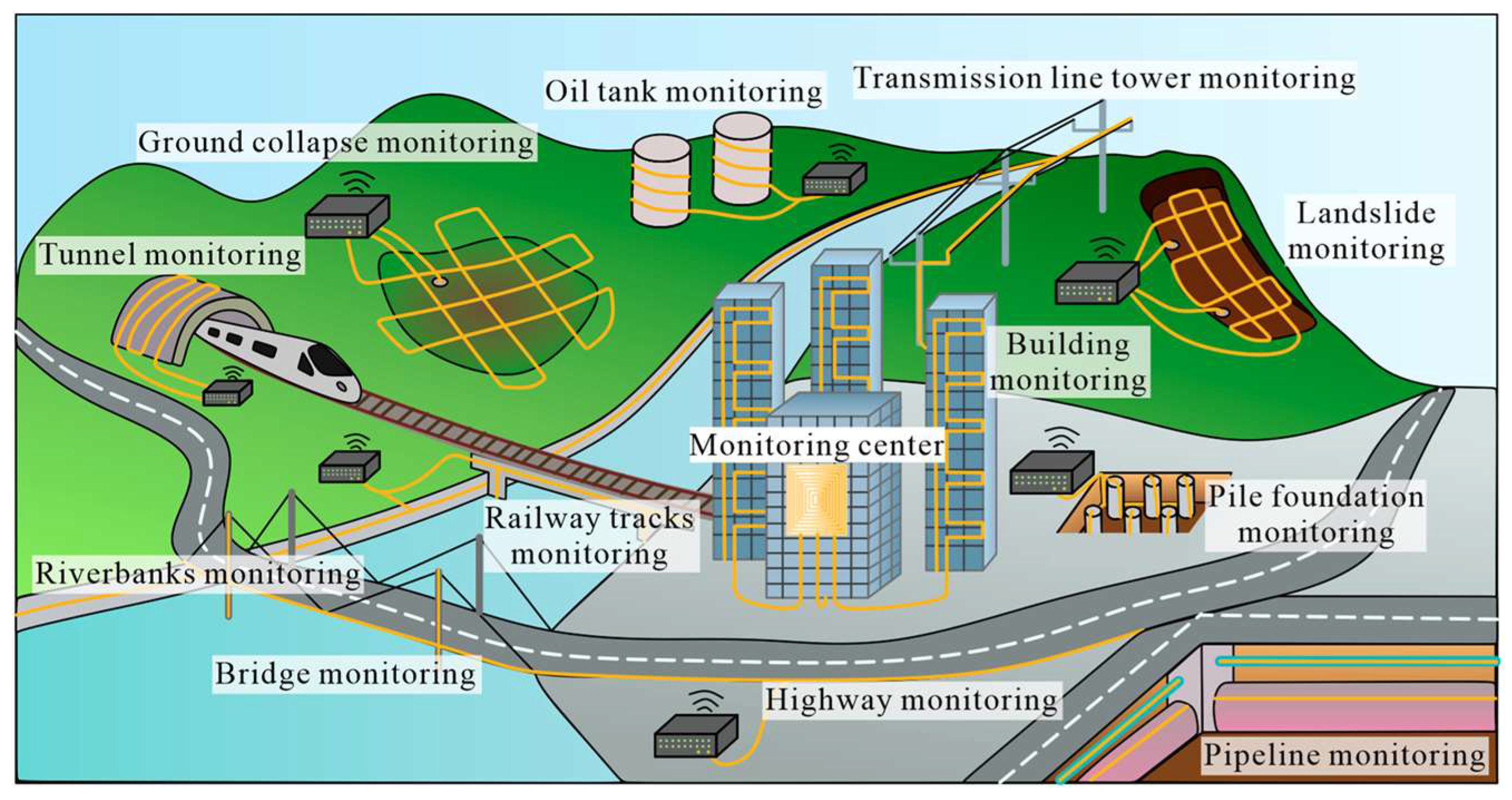




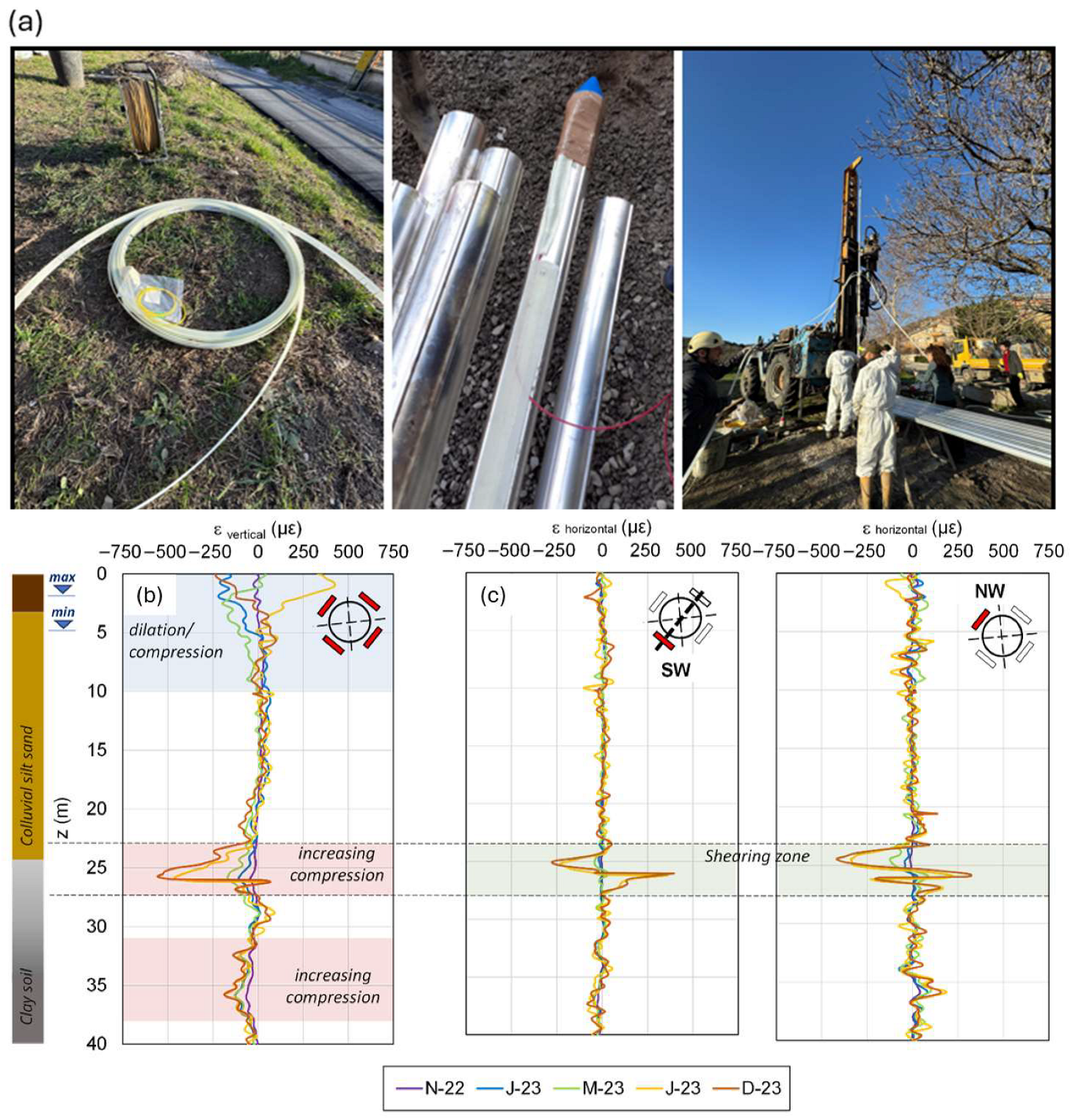



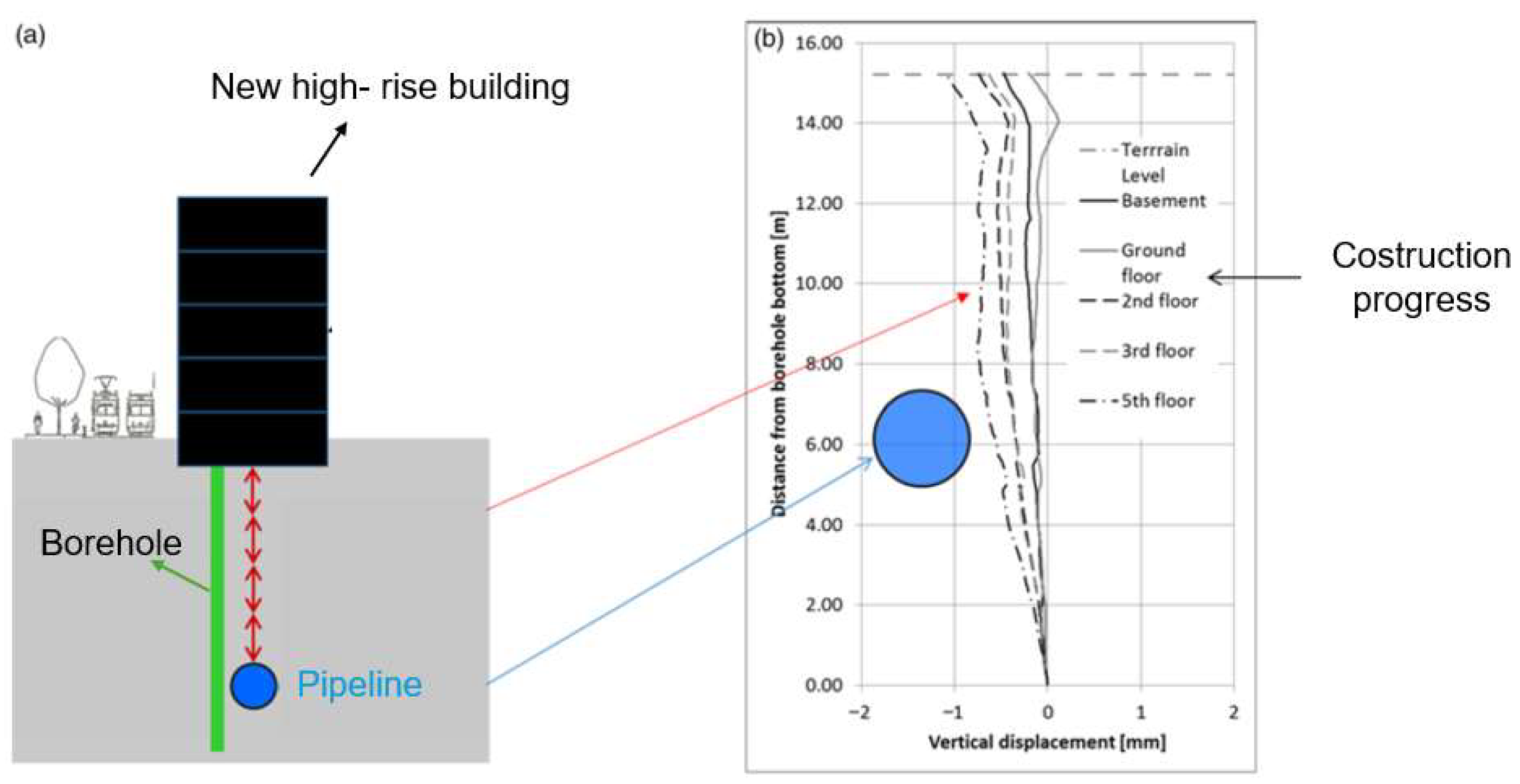
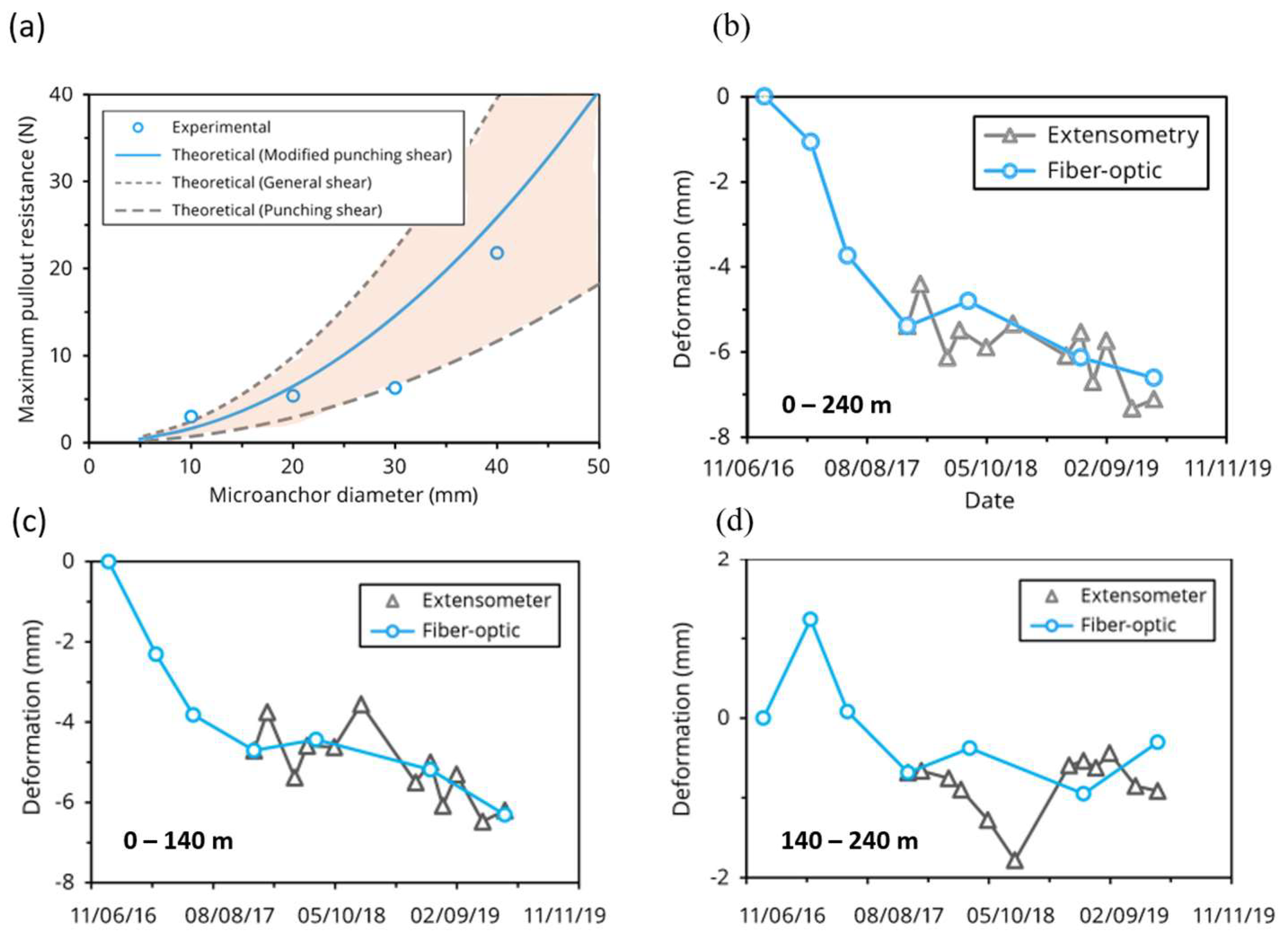
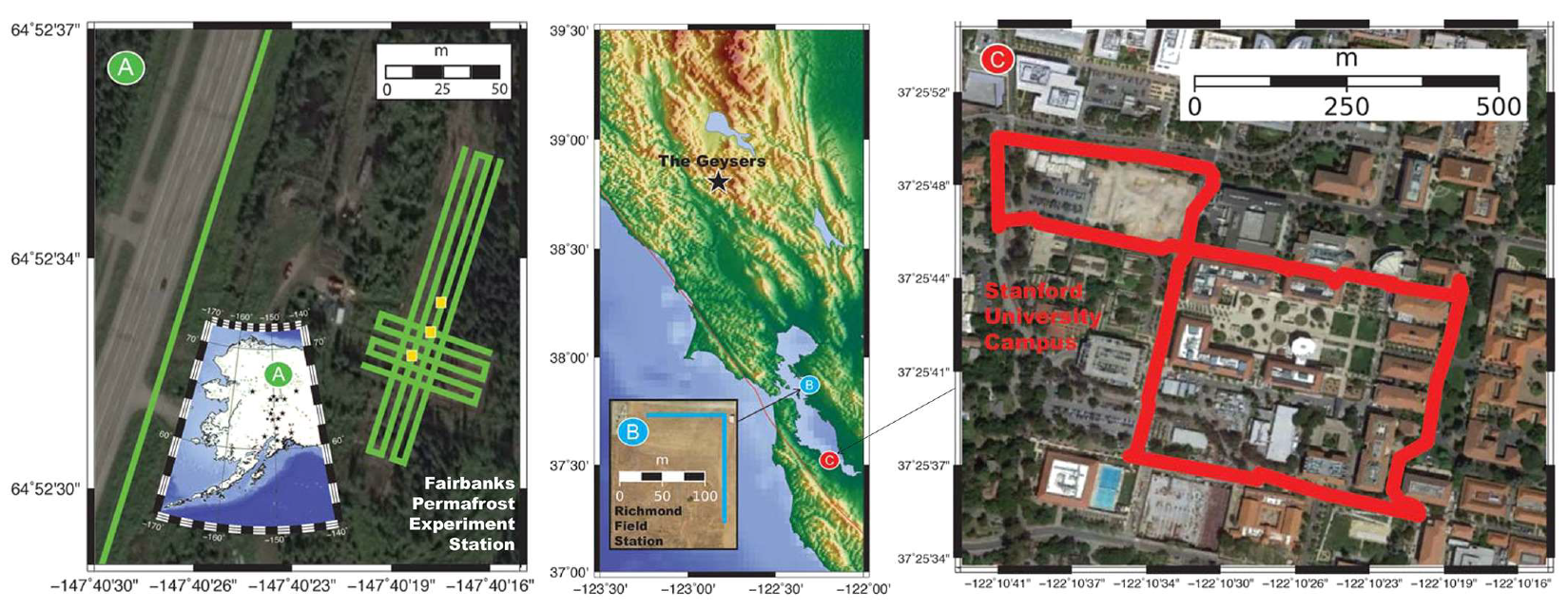


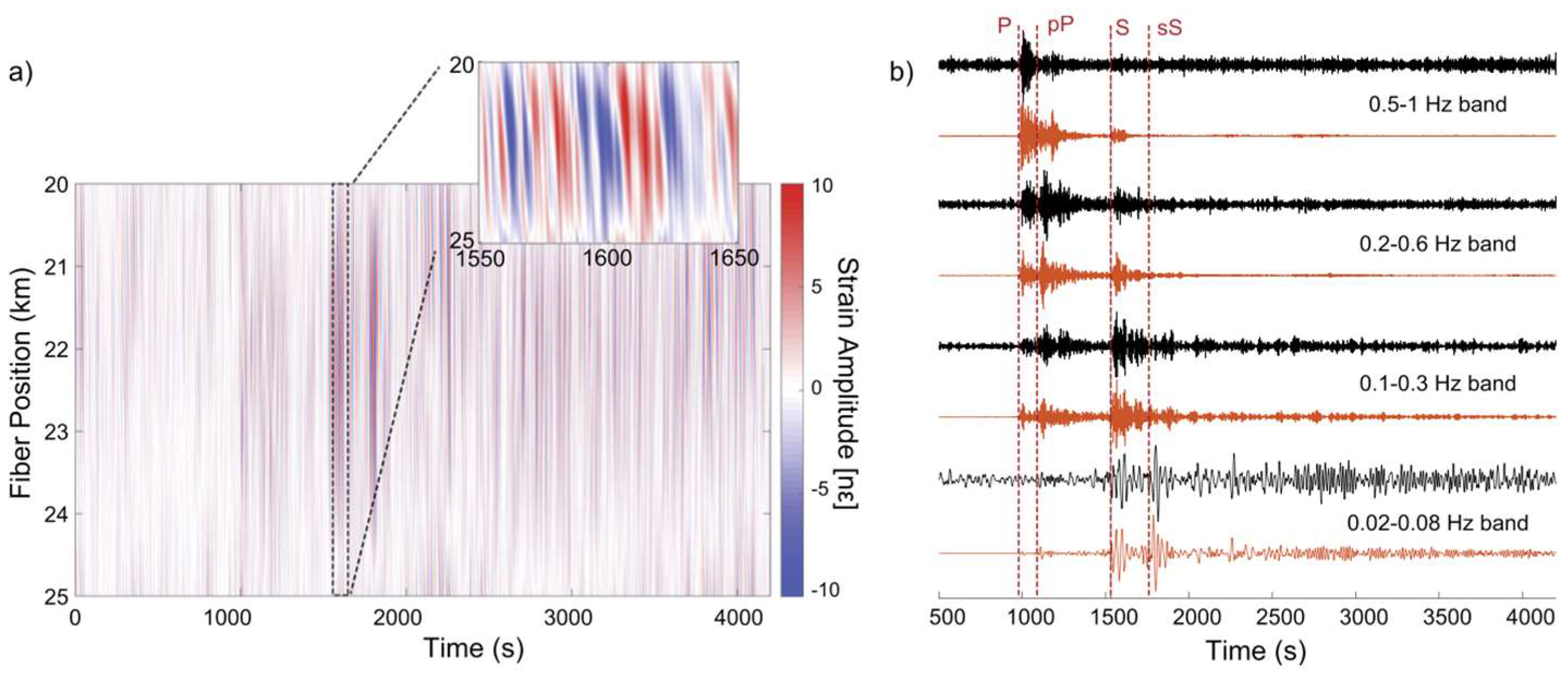
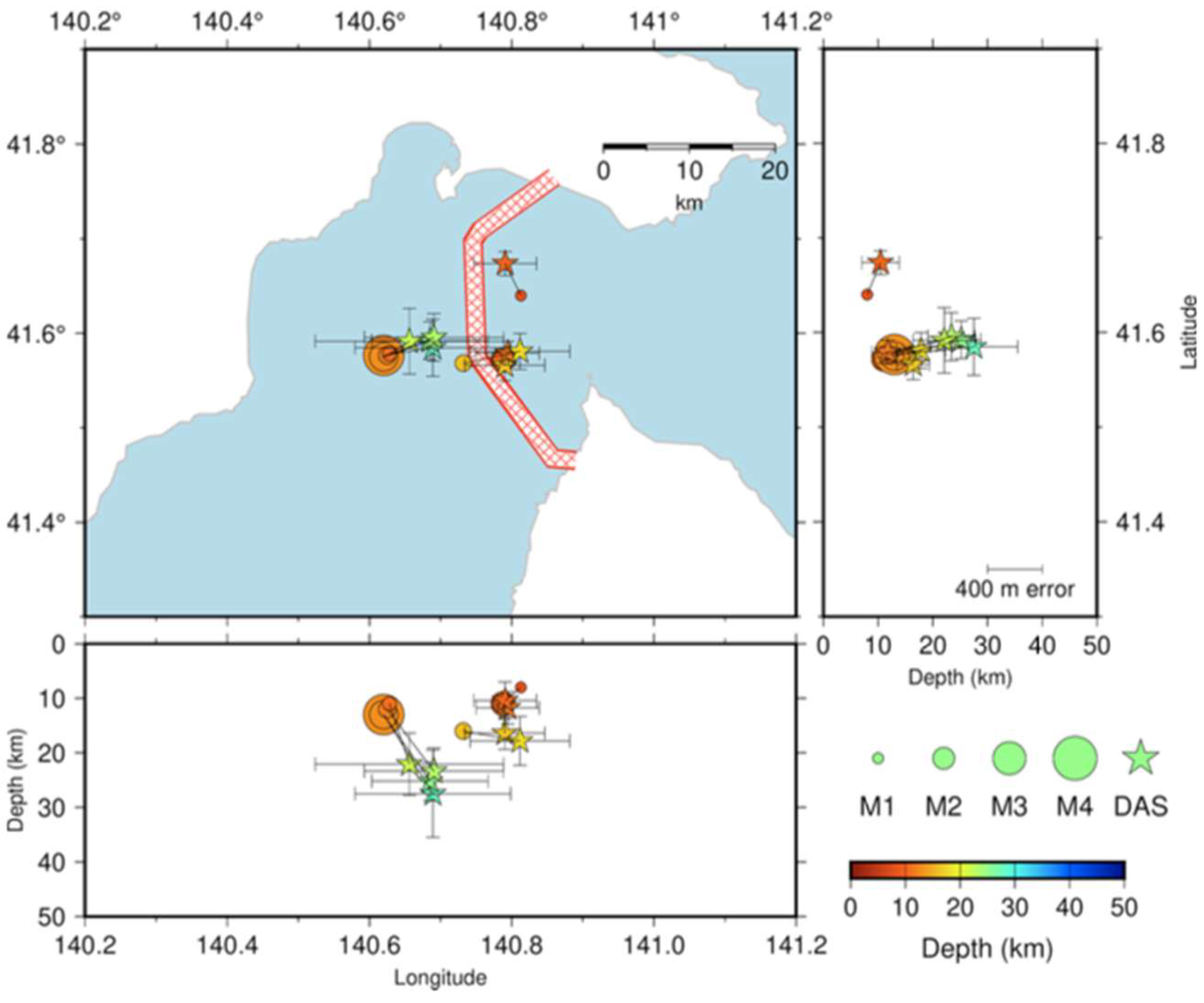
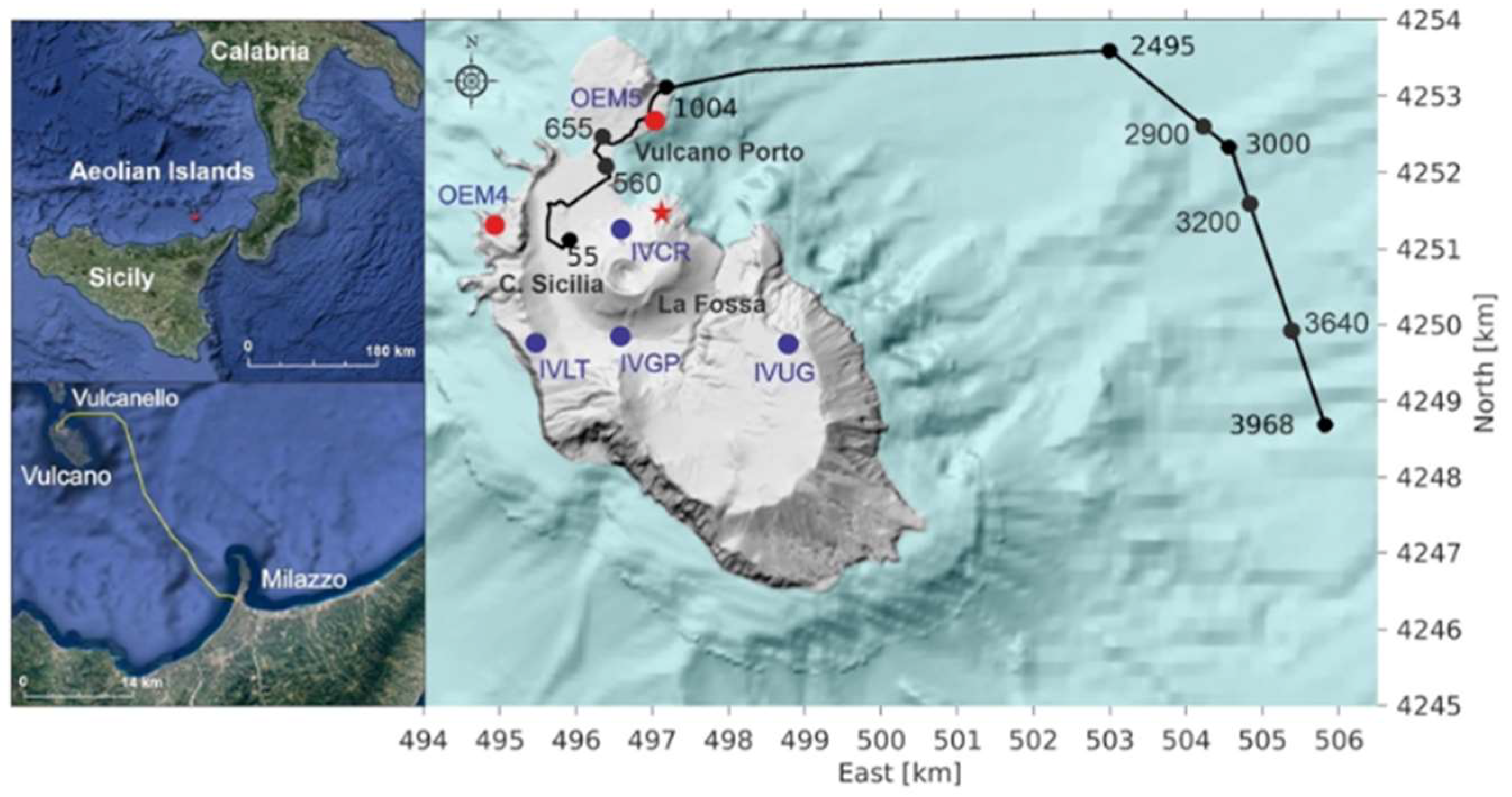
| Sensing Technology | Sensing Parameters | Accuracy | Sensing Range | Spatial Resolution | Advantages | Limitations |
|---|---|---|---|---|---|---|
| BOTDR | Strain Temperature | ±20 µε ±1.0 °C | ≈100 km | ≈1 m | Good sensitivity, single-ended measurements | High equipment cost, limited spatial resolution |
| High equipment cost, limited resolution for long-distance BOTDA | Strain Temperature | ±20 µε ±1.0 °C | ≈100 km | 10 cm–1 m * | Good sensitivity, high spatial resolution over medium distances | High equipment cost, limited spatial resolution over long distances |
| BOFDA | Strain Temperature | ±20 µε ±1.0 °C | 80 km | 1 cm–1 m * | Very high spatial resolution | Costly equipment, complex system setup |
| OFDR | Strain Temperature | ±2 µε ±0.1 °C | 70 m | ≈1 mm * | Good sensitivity, ultra-high spatial resolution | High equipment cost, limited sensing distance |
| Φ-OTDR | Strain Temperature Vibration | ±10 nε | 100 km | 1–10 m * | High sensitivity, fast acquisition rate | High equipment cost, complex data processing, limited spatial resolution |
| DFOS Method | Spatial Resolution/Accuracy | Application | Achievement | Advantages | Disadvantages | Reference |
|---|---|---|---|---|---|---|
| BOTDA | 0.05 m to 1 m/7.5 µε to 20 µε | Trench in roads to locate sliding mass boundaries | Qualitative agreement with traditional instruments | Distributed strain monitoring with spatial resolution higher than traditional instruments | Cable protection, installation procedure, and data interpretation methods | [52,53,55,65,66] * [23,71] ** [16,45,78,79,80] *** |
| Vertical extensometer for monitoring subsidence | ||||||
| DFOS sensors with micro-anchors: laboratory and field tests | ||||||
| Monitoring of soil subsidence and soil crack formation | Quantitative measurements in agreement with traditional instruments | |||||
| Laboratory test on DFOS-inclinometer | ||||||
| In-site monitoring of fast rain-induced landslide | ||||||
| Study of a slow-moving sinkhole | ||||||
| BOFDA | 0.2 m to 0.5 m/20 µε | Monitoring of rain-induced landslides in a physical model | ||||
| Extenso-Inclinometer for monitoring of slow landslide | Standardization of the fiber optic installation process and 3D detection of slope deformation | Need for specialist skills for data interpretation; high cost of the control unit | [58] * | |||
| BOTDR | 0.75 m to 1.0 m | Monitoring of the Mejiagou landslide | Identification of the deformation phenomenon. | Ability to detect and interpret complex strain distributions; provides detailed insights into landslide mechanics and evolution | Installation procedure and data interpretation methods; need for a traditional instrument to interpret strain distributions | [53,66] * [80] *** |
| Subsidence monitoring | ||||||
| CPT-based installation of fiber optics to monitor vertical displacements | ||||||
| OTDR | 0.25 m to 0.5 cm | Laboratory validation of a 36 mm-diameter rod integrating a fiber optic sensing (FOS) system and on-site tests | The progressive deformation behavior of the slope was accurately captured | Enables potential sensor multiplexing for deep landslide monitoring. | The system remains quasi-distributed, and field testing is required to validate its effectiveness | [55] * |
| OFDR | 10 mm/not specified | Monitoring of rain-induced surface landslides in a large-scale physical model using FO cable anchored with geogrids | Identification of deformation phases | High spatial resolution, allowing instability precursors to be detected in unprecedented detail | Sensitivity to installation conditions; limitations of the physical model; costs and skills | [40] ** [81] *** |
| Optical fiber installed in a surface trench; airbag inflation/deflation test to simulate deformations | ||||||
| DAS | 4 m/µε | A 925 m-long fiber-optic cable buried 10 cm deep; monitoring during a three-day rainy event | Detection of hidden deformation processes, classification of seismic signals | High sensitivity; ability to detect dynamic phenomena in real time; ability to detect precursor events | Need to optimize cable geometry to detect deeper, multidirectional deformations; poor mechanical coupling between cable and ground; limited ability to detect small events | [67] * [73,76,77] ** |
| Laboratory simulation of artificial seismic signals | ||||||
| Use of dark fibers for avalanche monitoring | ||||||
| Landslide monitoring | ||||||
| DAS | 1 m to 100 m | Existing telecom fibers | Good agreement with traditional seismometers | Large area monitoring, subsea monitoring, no need for co-located power supply | Detection of strain components along the fiber path only, low signal-to-noise ratio, ML algorithms required for data analysis | [83,84,85,86,88,92,93,94] **** |
| Custom-deployed fibers | 3D strain detection exploiting helically wound fiber cables | [87] **** | ||||
| L-shaped fiber cable: strain in two orthogonal directions | [89] **** |
Disclaimer/Publisher’s Note: The statements, opinions and data contained in all publications are solely those of the individual author(s) and contributor(s) and not of MDPI and/or the editor(s). MDPI and/or the editor(s) disclaim responsibility for any injury to people or property resulting from any ideas, methods, instructions or products referred to in the content. |
© 2025 by the authors. Licensee MDPI, Basel, Switzerland. This article is an open access article distributed under the terms and conditions of the Creative Commons Attribution (CC BY) license (https://creativecommons.org/licenses/by/4.0/).
Share and Cite
Coscetta, A.; Catalano, E.; Damiano, E.; de Cristofaro, M.; Minardo, A.; Molitierno, E.; Olivares, L.; Vallifuoco, R.; Zeni, G.; Zeni, L. A Review of Strain-Distributed Optical Fiber Sensors for Geohazard Monitoring: An Update. Sensors 2025, 25, 6442. https://doi.org/10.3390/s25206442
Coscetta A, Catalano E, Damiano E, de Cristofaro M, Minardo A, Molitierno E, Olivares L, Vallifuoco R, Zeni G, Zeni L. A Review of Strain-Distributed Optical Fiber Sensors for Geohazard Monitoring: An Update. Sensors. 2025; 25(20):6442. https://doi.org/10.3390/s25206442
Chicago/Turabian StyleCoscetta, Agnese, Ester Catalano, Emilia Damiano, Martina de Cristofaro, Aldo Minardo, Erika Molitierno, Lucio Olivares, Raffaele Vallifuoco, Giovanni Zeni, and Luigi Zeni. 2025. "A Review of Strain-Distributed Optical Fiber Sensors for Geohazard Monitoring: An Update" Sensors 25, no. 20: 6442. https://doi.org/10.3390/s25206442
APA StyleCoscetta, A., Catalano, E., Damiano, E., de Cristofaro, M., Minardo, A., Molitierno, E., Olivares, L., Vallifuoco, R., Zeni, G., & Zeni, L. (2025). A Review of Strain-Distributed Optical Fiber Sensors for Geohazard Monitoring: An Update. Sensors, 25(20), 6442. https://doi.org/10.3390/s25206442










